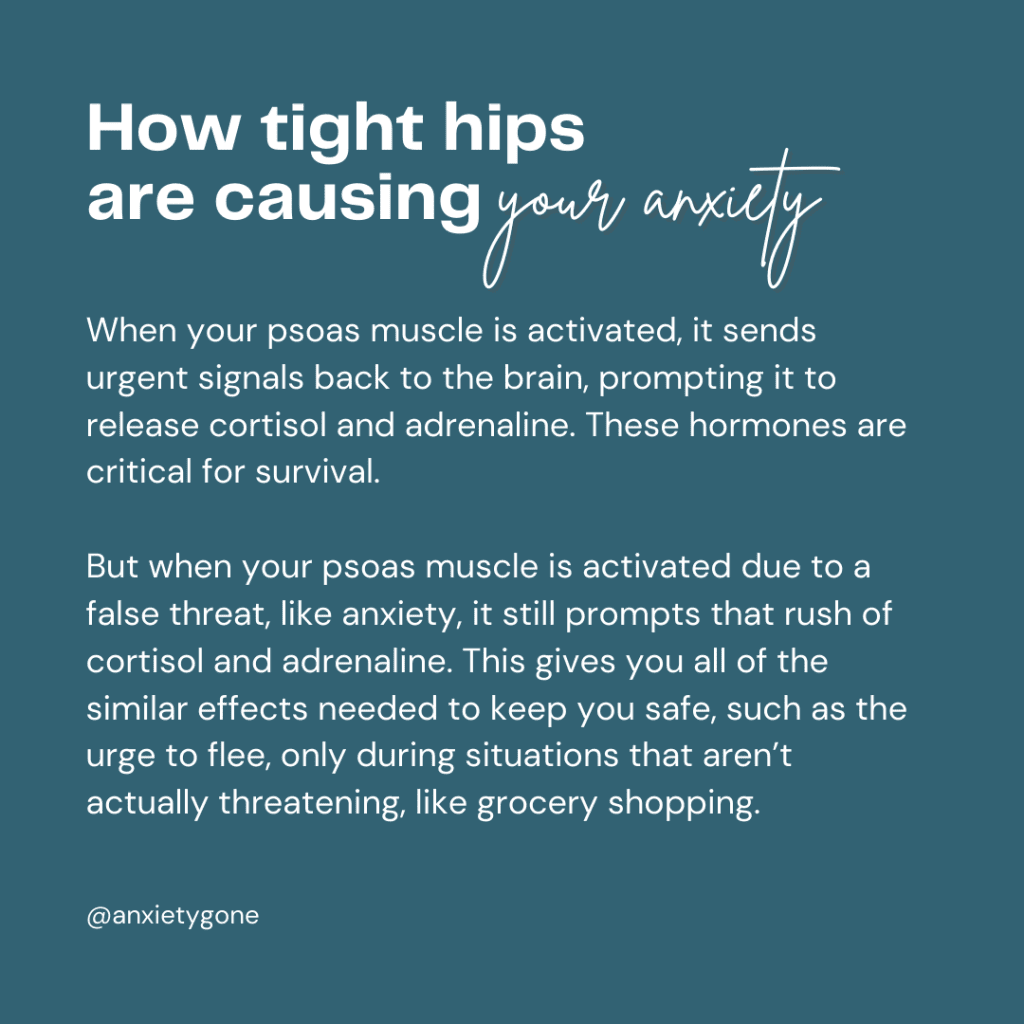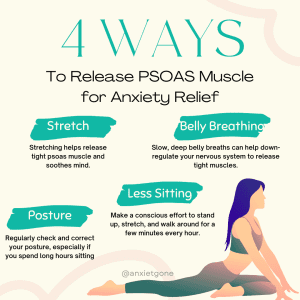Full Disclosure: Clicking on these links could mean a tiny commission for me, at no extra cost to you.
When it comes to managing anxiety and stress, we often think about the mind and its intricate workings. But did you know that a deep muscle within your body, the psoas muscle, plays a crucial role in your emotional well-being? Nestled deep in the core, this muscle is more than just a physical connector. It’s a hidden powerhouse that directly influences your mental state, storing your emotions and trauma, and causing physical and mental distress. The good news: you can use simple exercises to release trapped emotions and completely restore your body and mental health.
Understanding the Psoas Muscle and Anxiety
The psoas muscle is often referred to as the “flight or fight muscle” as it is intricately tied to our fight or flight response. Its central location and connection to the diaphragm make it uniquely susceptible to emotional tensions and stressors, which can transform psychological stress into physical discomfort.
This dynamic shows the intricate bidirectional communication between our brain and muscles. When your psoas muscle is activated, it sends urgent signals back to the brain, prompting it to release cortisol and adrenaline. These hormones are critical for survival.
But when your psoas muscle is activated due to a false threat, like anxiety, it still prompts that rush of cortisol and adrenaline. This gives you all of the similar effects needed to keep you safe, such as the urge to flee, only during situations that aren’t actually threatening, like grocery shopping.
The Physiological Link
Stress and anxiety can lead to a tightening of the psoas, creating a cycle of physical discomfort and emotional turmoil. Recognizing the signs of a strained psoas muscle, such as chronic lower back pain or a sensation of tightness in the hip region, can be the first step toward addressing underlying emotional strains.
The Psoas Muscle and Its Impact on Mental Health
The connection between the psoas muscle and mental health is supported by a growing body of research that recognizes the muscle’s role in regulating the nervous system. A tight psoas can contribute to a perpetuated state of stress, signaling the body to remain in a constant state of alertness, thereby exacerbating anxiety symptoms.
Techniques for Managing Stress and Anxiety Through the Psoas Muscle
Ready to transform your diet?
Beyond Body offers personalized wellness plans designed to help you make healthier food choices that naturally boost dopamine and keep you feeling great. Don’t miss out on our exclusive discount up to 50% off on a personalized wellness plan - start your journey to a happier, healthier you today! Visit Beyond Body and claim your discount now!
Claim Discount Here
Addressing the health of the psoas muscle can serve as a powerful tool in managing stress and anxiety. Through targeted therapy and exercises to release trapped emotions, you can experience significantly less anxiety and stress. Incorporating specific lifestyle changes that nurture the psoas can also lead to noticeable improvements in your physical and mental health.
Exercises to release trapped emotions
Releasing tension in the psoas muscle not only improves physical flexibility and reduces pain but can also have a significant impact on mental health by reducing anxiety and stress levels. Here are exercises to release trapped emotions to help release the psoas muscle and contribute to a calmer, more balanced mental state:
1. Psoas Stretch
- Kneel on one knee, with the other foot in front, flat on the ground, creating a 90-degree angle with both knees.
- Push your hips forward gently until you feel a stretch in the front of your hip of the leg that’s kneeling.
- Hold this position for 20-30 seconds, then switch sides.
2. Supine Psoas Stretch:
- Lie on your back near the edge of a bed or table with one leg hanging off the side and the other leg bent at the knee, foot flat on the surface.
- Allow the hanging leg to relax completely, feeling a stretch through the front of the thigh and hip.
- Hold for 20-30 seconds, then switch legs.
3. Constructive Rest Position:
- Lie on your back with your knees bent and feet flat on the floor, hip-width apart.
- Place your feet in a position that’s comfortable, usually about 12-16 inches from your buttocks.
- Rest your hands on your abdomen or by your sides, and breathe deeply, allowing your lower back and psoas to relax.
- Stay in this position for 5-10 minutes.
4. Lunging Hip Flexor Stretch:
- Step one foot forward into a lunge position, keeping your back leg straight and heel off the ground.
- Place your hands on your hips or the front knee and gently push your hips forward, feeling a stretch in the front of your hip on the back leg.
- Hold for 20-30 seconds, then switch sides.
5. Seated Butterfly Stretch:
- Sit on the floor with your back straight and the soles of your feet together in front of you.
- Hold onto your feet or ankles and gently press your knees towards the floor with your elbows, keeping your back straight.
- Hold the stretch for 20-30 seconds.
6. Warrior I Yoga Pose:
- Stand with feet hip-width apart, then step one foot back about 3-4 feet, turning the back foot slightly outward.
- Bend your front knee to a 90-degree angle, keeping your back leg straight.
- Raise your arms above your head, and gently arch back, looking up. Hold for several breaths, then switch sides.
7. Deep Belly Breathing:
- Find a comfortable seated or lying position.
- Place one hand on your chest and the other on your belly.
- Breathe in deeply through your nose, allowing your belly to rise more than your chest.
- Exhale slowly through the mouth.
- This exercise can help reduce the fight-or-flight response and encourage relaxation.
Incorporating exercises to release trapped emotions into your self care routine can help alleviate tension in the psoas muscle, promoting physical and mental well-being. Always listen to your body and adjust the intensity of the stretches to avoid discomfort.
Ready to Release That Stress?
Unlock Your Hip Flexors guides you through a therapeutic system that relieves stress, boosts your energy, and helps you feel amazing. It’s time to take care of your body and mind!
Lifestyle Tips for Psoas Muscle
Releasing tension in the psoas muscle and enhancing mental health can be significantly supported by adopting certain lifestyle changes. These adjustments aim to create a balance between physical activity, rest, and emotional well-being, helping to maintain the health of the psoas muscle and reduce overall stress. Here’s a list of lifestyle changes that can be beneficial:
1. Improve Posture
Regularly check and correct your posture, especially if you spend long hours sitting. Adopting an ergonomic workstation, ensuring your back is supported, and your feet are flat on the ground can help prevent the shortening and tightening of the psoas muscle.
Buy Now: Available on Amazon
2. Incorporate Movement into Your Routine
Sedentary lifestyles can lead to psoas muscle tightness. Make a conscious effort to stand up, stretch, and walk around for a few minutes every hour. Opt for a standing desk if possible, or incorporate short walks during your day.
Buy Now: Available on Amazon
3. Mindful Movement Practices:
Engage in practices like yoga, Pilates, or Tai Chi, which not only improve physical health but also focus on breath work and mindfulness, reducing stress and promoting mental well-being.
- Best for online yoga: Yoga Burn or Yoga Download
- Best for online tai chi: Dragon Door
- Best for online breathwork: Inward Breathwork (Get your first month free here)
- Best for mindfulness: Mindfulness App (Get an exclusive discount here)
- Best for tapping: The Tapping Solution (Get 14-day free trial here)
4. Hydration
Adequate water intake is crucial for muscle health, including the psoas. Ensure you’re drinking enough water throughout the day to help maintain muscle elasticity and prevent cramps.
5. Nutrition
A balanced anxiety diet rich in magnesium, calcium, and potassium can support muscle function and reduce the risk of cramps and tightness. Incorporating anti-inflammatory foods can also help manage and prevent pain.
6. Manage Stress
Chronic stress can cause the psoas muscle to tighten as part of the body’s fight or flight response. Adopting stress management techniques such as meditation, deep breathing exercises, journaling, or seeking professional support can help mitigate this.
- Best for Breathwork : Inward Breathwork (Get your first month free here)
- Best for Mindfulness: Mindfulness App (Get an exclusive discount here)
- Best for Emotional Release : The Tapping Solution (Get 14-day free trial here)
- Best for Meditations : Headspace (Get a 14-day trial here)
7. Get Enough Sleep
Quality sleep is crucial for both mental health and muscle recovery. Create a calming bedtime routine, maintain a consistent sleep schedule, and ensure your sleeping environment is conducive to rest.
8. Professional Therapy
Consider seeking the help of a physical therapist, massage therapist, or chiropractor who can provide specialized techniques for releasing the psoas muscle, such as deep tissue massage or specific stretches and exercises to release trapped emotions. Chiropractors can provide targeted care for the psoas muscle, a key player in core stability and hip flexion. Through manual techniques like soft tissue manipulation and adjustments, chiropractors can alleviate tension and tightness in the psoas, promoting improved posture, range of motion, and reduced discomfort. By addressing imbalances in the psoas, chiropractors contribute to overall musculoskeletal health, enhancing performance in physical activities and daily life.
You can use an online program too. Unlock Your Hip Flexors is this program endorsed by physical therapists, wellness coaches and clinical studies. It offers an effective, evidence-based healing regime that you can do right from home. It also comes with a 60 day money back guarantee, so you can check it out and see if it’s something you’d like to do.
Learn more here: Unlock Your Hip Flexors
Final Thoughts on Hips and Emotions
Navigating through the complexities of chronic anxiety and tight hip flexors is possible with a few simple psoas stretches, exercises to release trapped emotions and lifestyle changes. Over time, these consistent actions can lead to amazing changes, reshaping your response to stress and enhancing your overall well-being.
For those looking to deepen their understanding and embark on a journey to unlock the full potential of their body, the “Unlock Your Hip Flexors” program offers a comprehensive guide to releasing and strengthening this crucial muscle. By focusing on the health of your psoas, you can take a significant step toward alleviating stress and fostering a deeper sense of calm and resilience. Start your journey today, and experience the transformative effects of a balanced, nurtured nervous system.













